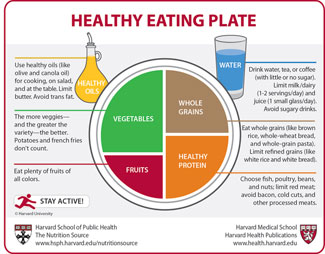By Jill Buonomo
Many people grew up learning to base their food choices on the U.S. Department of Agriculture’s Food Pyramid, which was recently reinvented as MyPlate. The updated guidelines, communicated via a simple, color-coded graphic, are focused on proper portions of the four major food groups. The plate is divided into sections for proteins, grains, fruits and vegetables — with a glass of milk beside it representing the dairy group.
But does it go far enough? The researchers at the Harvard School of Public Health and Medical School didn’t think so. They’ve created their own guidelines, dubbed the Healthy Eating Plate. The Harvard guidelines are presented as a more specific alternative to the USDA’s MyPlate; an option based on science and created without any political or commercial pressures from food industry lobbyists.
The Harvard Difference
The Healthy Eating Plate is similar to USDA’s MyPlate in that it’s a colorful and graphical representation of a healthy diet. But it goes much further in terms of distinguishing healthy choices within each food group.
For example, a vegetable is not a vegetable in the eyes of the Harvard nutritionists. While the vegetable section is the largest, they suggest forgoing potatoes (and by extension, French fries) altogether. Likewise, whole grains are recommended over refined options like white rice and white bread.
Foodie Factions
Some notable food experts, such as Marion Nestle (author and New York University nutritionist) have suggested that the Healthy Eating Plate might have gone a bit too far, and that the pleasures of enjoying certain foods (like potatoes) should be considered. Another noticeable difference is the Healthy Eating Plate’s distinction between healthy and unhealthy proteins. Poultry, fish, beans and nuts are recommended, while red meat, bacon, cold cuts and other processed meats are discouraged.
Also missing is the glass of milk. Instead, a glass of water appears beside the plate, with a suggested limitation of one to two servings a day of low-fat dairy. Water and unsweetened tea and coffee are also suggested, while sugary drinks are discouraged.
While MyPlate does not distinguish between types of fats, the Healthy Eating Plate emphasizes the need for healthy fats, such as olive and canola oils.
Absent from MyPlate is any mention of physical fitness, while an icon of a running figure below the Healthy Eating plate highlights the role of daily activity in maintaining a healthy body.
Surprisingly, many leading food experts have yet to weigh in on the new dietary guidelines. While the USDA’s approach could be praised for its simplicity in communicating with a general audience, some might argue that it doesn’t go far enough to educate Americans about healthy eating.
Cynthia Harriman, Director of Food and Nutrition Strategies for the Whole Grains Council/Oldways (the organization that developed the first Mediterranean Diet Pyramid in 1993 in conjunction with the Harvard School of Public Health) says, “The bottom line: rampant obesity and chronic disease tell us that Americans can use all the models for healthy eating we can get. Whether it’s Oldways’ Pyramids and Plates of Expression, Harvard School of Public Health’s Healthy Eating Plate, USDA’s MyPlate, or some other effort, we’re all on the same team, working to change the way people eat for the better.”
The news stream will continue to be flooded with diet and nutrition news, but consumers can take heart that there are simplified sources to turn to for general guidelines.

